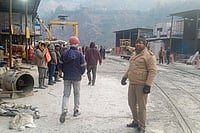Irreconcilable Differences In Policy Formulation
- Industry ministry: Create zones with relaxed labour laws where jobs can be concentrated. There will be so many jobs that hire-and-fire will, basically, hardly even matter.
- Labour ministry: Do away with procedural roadblocks; but don’t even think about amending labour laws to encourage hire-and-fire,which already exists and is plenty bad enough.
- Planning Commission: Opposed to hire-and-fire. Says zones cannot define the policy; commission is looking to create consensus on a broad-strokes manufacturing policy.
- NMCC: Relies heavily on skill development; says jobs, skills and manufacturing growth go hand-in-hand. But, there are simply way too many proposals to actually implement.
***
As a dismayed government tries to come to terms with unexpectedly slow growth this year, there is a belated attempt to tackle the elephant in the room, manufacturing. India has long harboured dreams of being a manufacturing powerhouse—now it’s trying to reconcile the differing views on the nuts and bolts for the next decade of growth. It won’t be easy: the Planning Commission, the National Manufacturing Competitiveness Council (NMCC), and the industry ministry have been working separately on a long-term manufacturing policy for years.
Most of these agencies have put forth suggestions and strategies, several of which are mutually irreconcilable and even unacceptable to key groups such as the powerful trade unions or environmentalists. An embattled government has taken matters into its own hands—with the PMO’s “high-level committee” on manufacturing stepping in—though no deadline has been announced for when its review will be completed (it will meet all players in early June).
This latest search for an overarching policy on industrialisation dates back to late 2004, when the NMCC was set up. In 2006, it released a strategy paper, which stated that skill development and boosting local consumption should form the basis for industrialisation. By 2009, the industry ministry had begun work on a policy, now circulating as a draft, which proposes new industrial zones, very similar to SEZs, where employment could be concentrated. Finally, as part of the preparations for the 12th Plan, the Planning Commission is also forming a programme to foster employment and growth through manufacturing.
The stated aim of the government is to create 100 million jobs—twice the number of organised industry jobs created since Independence—by 2025. India’s labour force is estimated at 500 million, with only a tiny percentage in the organised sector, which typically requires skills and may provide social security.
But a crunch point has arisen with the trade unions being the first to protest that the government did not involve them in negotiations to determine the latest policy. They fear farmland will be forcibly acquired for industrial use, and labour laws will be watered down drastically in the industrial zones. “The industry ministry’s draft is not acceptable to us,” says Baijnath Rai, secretary-general of the Bharatiya Mazdoor Sangh. All the unions, including aituc, CITU, INTUC and HMS have locked horns with what they say amounts to “hire-and-fire” provisions in the draft. “The new industrial policy will not encourage employment, but will further weaken labour’s bargaining position,” avers Rai.
The Planning Commission, which is still finalising its policy, has identified five broad objectives, including simpler regulation, skill development, new technology and easing procedural burdens. Planning Commission member Arun Maira says the high-level committee, to which he was appointed in March, will bridge the different views on land and labour issues by “reframing” the debate. “We (the Planning Commission and the PMO’s committee) are saying that there needs to be fairness and flexibility in labour law, not hire and fire, which the unions (rightly) oppose,” Maira says.
For instance, the policy will look for ways to increase the numbers of “talented managers”, while driving home the point that implementing a policy of seasonal hiring in areas where jobs abound may not be all that bad an idea. “In Japan, Germany or Korea, middle managers are highly capable. We have somehow lost these talented foremen and floor managers. Through our discussions, we’ll find ways to ensure a very high standard for them,” Maira adds. An adequate social security provision for laid-off workers will also be installed. A sample unemployment insurance has been prepared, though the industry ministry wants some changes made to it.
The PMO did not respond to a questionnaire on how the opposing viewpoints can be adequately reconciled. Still, the labour ministry has clarified to the Planning Commission and the high-level committee at a joint meeting held in mid-May that it will accept streamlining clearances and procedures—but will not “dilute” labour laws. “Unless there is a firm proposal that involves watering down the Factories Act or the Construction Workers Act, there is no cause for alarm,” says Prabhat C. Chaturvedi, secretary, labour and employment. “But our position is the same as it was on SEZs: that there can be no exemption from labour laws in any pocket of industrial activity,” he says.
For the moment, the drafts are exactly that—drafts and not official policy—but they come in the backdrop of rising protests against land acquisition and environmental concerns. Management consultant Gurcharan Das says the only way to get out of such logjams is to improve the negotiation skills of each group. “These things do get done,” Das says. “It only needs to be tackled with zeal. One good way would be to not reopen permissions once they are given. Without large-scale infrastructure, it will not be possible to grow,” he adds.
An older commission, the National Commission on Enterprises in the Unorganised Sector (NCEUS), had suggested developing “clusters” of manufacturing in the summer of 2008. It had proposed setting higher allocations for India’s unique manufacturing clusters—such as Madhya Pradesh’s Chanderi saree cluster, or leather-makers in Maharashtra, or small-scale industrial goods producers in Gujarat. K.P. Kannan, director, Centre for Development Studies, Trivandrum, says most NCEUS recommendations have come to naught. That’s because “the idea is not to create jobs through manufacturing as the government has been proposing to do, but to create manufacturing through jobs”.
While the debate continues to simmer, the number of proposals being circulated has come as a surprise to both unions and sections of industry. “You can achieve a lot even with the existing schemes,” says economist Rajiv Kumar, recently appointed as secretary general, FICCI. “And if you come up with something new, please have a timeline for implementation,” he says. “Everything, and I mean everything, in India should be focused on employment growth.”
Manufacturing, the big source of skills, livelihood and security, has stagnated for at least 15 years with only a 17 per cent share of the GDP, and it has added woefully few new jobs. A new attempt to revive manufacturing is under way, but all discussions are being swept away, typically, in the war between “hard decisions” and “protectionism”. If there’s a happy medium, it’s not on the burner yet.


























